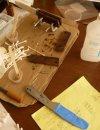- Joined
- Sep 16, 2002
- Messages
- 1,577
I glued up 2 knives last night around dinner time. I emptied what was left in the tube of Loctite 60 min. epoxy into my little cup, stirred it well for a couple of minutes, and did the first knife. There was a bit less epoxy left than I had thought looking at the syringe, so I decided to open a new package of epoxy and mix up a new batch to avoid running out half way through the 2nd knife.
This morning I checked on things, and I found that the epoxy in the mixing cup from the first knife wasn't hard yet. That's strange...better check the actual knife. Stuck the overflow in a couple of spots with a toothpick, and it's still soft too. This epoxy worked great about a week ago and was recently purchased, so I know it's not old or anything. It's consistency is stiff, but soft...about like the natural peanut butter that you stir up to mix the oil back in, after it's been refrigerated.
What should I do, here? Should I wait more time (I'm not in a rush)? Should I try to hurry up and clean it all off and re-do it (assuming I'm even able to do that at this point)?
This morning I checked on things, and I found that the epoxy in the mixing cup from the first knife wasn't hard yet. That's strange...better check the actual knife. Stuck the overflow in a couple of spots with a toothpick, and it's still soft too. This epoxy worked great about a week ago and was recently purchased, so I know it's not old or anything. It's consistency is stiff, but soft...about like the natural peanut butter that you stir up to mix the oil back in, after it's been refrigerated.
What should I do, here? Should I wait more time (I'm not in a rush)? Should I try to hurry up and clean it all off and re-do it (assuming I'm even able to do that at this point)?

